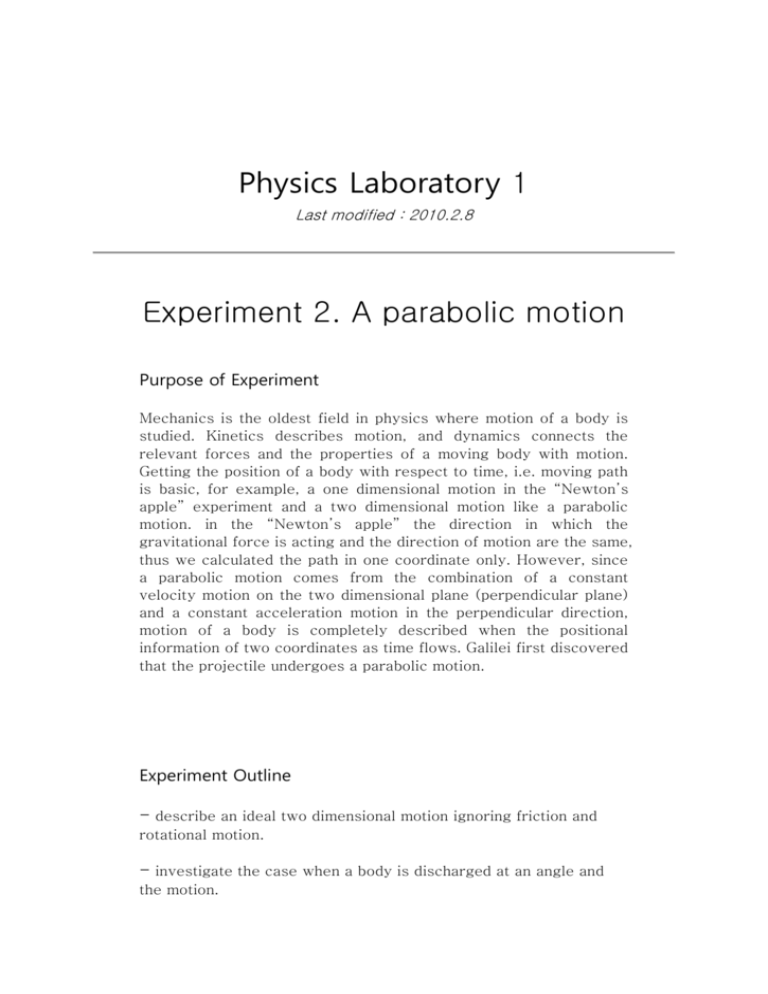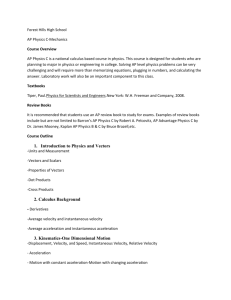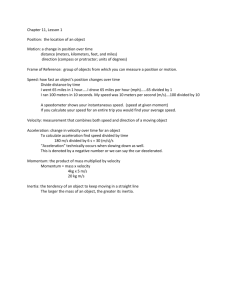Physics Laboratory 1 Last modified : 2010.2.8 Experiment 2. A
advertisement

Physics Laboratory 1 Last modified : 2010.2.8 Experiment 2. A parabolic motion Purpose of Experiment Mechanics is the oldest field in physics where motion of a body is studied. Kinetics describes motion, and dynamics connects the relevant forces and the properties of a moving body with motion. Getting the position of a body with respect to time, i.e. moving path is basic, for example, a one dimensional motion in the “Newton’s apple” experiment and a two dimensional motion like a parabolic motion. in the “Newton’s apple” the direction in which the gravitational force is acting and the direction of motion are the same, thus we calculated the path in one coordinate only. However, since a parabolic motion comes from the combination of a constant velocity motion on the two dimensional plane (perpendicular plane) and a constant acceleration motion in the perpendicular direction, motion of a body is completely described when the positional information of two coordinates as time flows. Galilei first discovered that the projectile undergoes a parabolic motion. Experiment Outline - describe an ideal two dimensional motion ignoring friction and rotational motion. - investigate the case when a body is discharged at an angle and the motion. - see the effect of friction on motion using the ball with high air friction. - repeat the one dimensional free falling experiment like ‘Newton’s apple’ and verify the reliability of measured data of the device. Experiment method The following devices are prepared for the experiment. (in the parentheses are the numbers prepared) A computer (1) A CCD camera (1) A reference ruler (1) A firing device (1) A plastic rod (1) Beads If you need anything else, ask the teaching assistant, visit the experiment preparation room (19-111) or prepare them yourself. There’s no specification of the experiment procedure although the following is recommended. Before the experiment, capture your own face using the CCE and put it on the cover of your report. 1) see what trajectories a body discharged at various angles takes and obtain the trace of the body as a function of time. ① set up the apparatuses as in the movie. Set up the camera so that the motion is observed from the side. It must be in the middle of where the firing device is and where the bead would fall. Put the reference ruler on the same plane (where motion occurs) of the discharger. (think about why we put the camera and the ruler there and discuss it in the result analysis.) Turn on the computer and run “I-CA”. click [file-camera configuration] on the menu and make sure the CCD screen is turned on. (movie) * Tip. Camera configuration 1. After running I-CA program, select the camera configuration in the file menu. 2. Push the menu of the remote control till the setup menu pops up. 3. Select the ALS/AES on the third row. 4. Select the LEVEL -FIX- OFF on the last row. 5. Select 1/250 6. Push BACK on the remote control and return to the previous. 7. Select AGS/SENS 8. Select LIGHT and NORMAL 9. Select SENS 10. Select X32 (32 times) 11. Push BACK twice to exit Refer to CCC screen adjustment(movie) and finish the initial device configuration. Adjust the discharger at the known angle. The discharger can be adjusted to three levels, but we use only first two levels. Insert the reference ruler into the discharger for coordinate configuration and click [file-capture screen] and record the movie for a short time. (movie) Click [file-coordinates setup] and open the movie just recorded and configure the coordinates.([starting point setup]-[end point setup]-[input length]-[next]-[point of reference(origin) setup]-[confirm]) ② click [file-capture screen] and specify the data saving path and shoot the bead to start the experiment. (movie) After saving data, select [file-analyze] and analyze the saved data. ([select the first frame]-[select the last frame]-[select the object]-[start analysis]-[save the analyzed data]) (movie) ③ after the analysis, save the data and you can see the image file used for analysis and the location data file of the object on the screen. (x and y coordinates as time flows, and Vx and Vy for each frame interval) ④ you can draw a graph obtained using Excel. (if you would like open data using Origin, open the data using Excel and select the file type as [text(delimited by tabs)] and save it and then open it) ⑤ you can obtain a graph where the x coordinate of the bead is linearly proportional to time and since the discharging angle in known, you can calculate the initial velocity. The velocity of x and y coordinates over time is the average speed between the two measured frames. Are the initial velocities from (a) and (c) the same? If not, why? The y coordinate of the bead is in the shape of a second order curve over time and since the time when y reaches the maximum can be calculated, gravitational acceleration can be obtained using the initial velocity previously calculated. Is it the same as the gravitational acceleration generally known? How does Vx change over time? Compare the result with the theoretically known value and discuss why the result is so. ⑥ Verify that you get the same result (superimpose the graphs with each other and do the fitting) by performing the experiment at the same angle more than three times and obtain the average and stddev. Repeat the experiment by varying the shooting angle (more than five different angles) including 45o. Obtain the flying time(T) before the projectile touches the ground, the horizontal displacement(R) and the maximum displacement(Rmax) when the shooting angle is 45 o from the graph and compare them with the theoretical values. If they differ, discuss the reason. 2) comparison using the balls of different masses Repeat the experiment using more than two of the beads with different masses. Does the mass of bead affect the parabolic motion? If so, discuss why. If not, what result do you get when the initial velocities of all the beads are the same? 3) Comparison with the ‘Newton’s apple’ experiment Perform a free falling experiment using more than two of the beads of different masses and compare the result with that of the ‘Newton’s apple’. Is the gravitational acceleration same? Is the mechanical energy conserved? Which case fits the theory better? Why is that so? (discuss the possible difference between the measurement method of this experiment and that of the ‘Newton’s apple’ experiment.) obtain the coefficient of restitution between the bead and the floor. (4) collision between the bead with parabolic motion and the bead with free falling motion Point the shooter to the bead for free falling motion and set it in falling motion at the same time with discharge. Observe the collision between two balls. (do not use any program) background theory [fig. 1] each directional component of the initial velocity is v0x=v0cosθ, v0y=v0sinθ Let us describe the two dimensional motion of a body discharged at some angle with the floor by solving of the second order differential equation. As in the figure, the force acting on a body discharged at the initial angle V0 with the floor at t=0+ is just the gravitational force in the direction of –y. (the external shooting force acts on it only until t=0) That is, there’s no force in the direction of x and thus no change of speed so acceleration is zero. However, there’s gravitational force in the direction of –y. thus you can obtain the following using the first law of Newton. (F=ma) (1) (2) Integrating (1) and (2), you can obtain each x and y component of the velocity over time. (3) (when t=0, the x component of the velocity is v0x=v0cosθ and you can get the constant of integration C1) that is, the velocity is constant since there’s no force in the direction of x. Integrating it again, you can obtain the change of x coordinate over time. (4) (5) When t=0, x(0)=x0 and you can get the constant of integration C2=x0. The y coordinate over time can be obtained in the same way. (6) (7) (8) (9) Rearrange the equation (5) with respect to time t, plug it in the equation (8) and rearrange it then you can get the trajectory of the body. You can obtain the flying time(T) before the projectile touches the ground by calculating the time when y(t)=0. (i.e. by solving a quadratic equation) (10) (11) The horizontal displacement(R) cane be calculated by plugging the above (11) into the equation (5). (Do it yourself.) if you obtained the answer, estimate the shooting angle when the horizontal displacement is maximum(Rmax). The maximum horizontal displacement is as follows (12) Now consider the friction effect of air. In general, a body with speed v feels friction force as follows (1<α<3, b is constant) (13) Suppose the friction force is proportional to speed then the equations (1) and (2) become (k=b/m) (14) (15) Integrating these, the velocity and the coordinates over time can be obtained. (16 ) (17) (18) After a long time, from the equation (16), the speed reaches a certain terminal speed. (vy= -g/k) from this, the coefficient of friction b is obtained. references ※ Questions ① in the case of a rifle in a western film, as the barrel gets longer, the time under the influence of force gets longer so the initial ejecting speed of the bullet increases and it flies longer. When you shoot the rifles with a longer barrel and a shorter barrel horizontally, from which rifle does the bullet fly longer? Consider the case of the experiment (4) together. ② theoretically, the maximum range is accomplished when the shooting angle is 45. That is, at the angle larger or smaller than this, the range becomes smaller than Rmax. thus there are two shooting angles that can reach a distance R. Obtain two possible evaluation angle of fire when the bead touches the ground at 50cm distance. (Assume the height of the discharger’s entry as floor. Ignore air friction as always.) [Use the initial speed obtained from the experiment (1)] The sum of two angles is constant. Obtain the sum. A method of processing the measurement data A method of analysis using graphs Isaac Newton – universal gravitation at the garden Galileo galilei – father of experimental physics who paved the way for Newton The effect of friction due to the air on falling Korea Research Institute of Standards and Science (KRISS) National Institute of Standards and Technology (NIST) Acceleration Due to Gravity Acceleration Due to Gravity-Lecture Notes ※a site with various applets of projectile motion http://physics.new21.org/pages/1/D/60/ Return to Index






